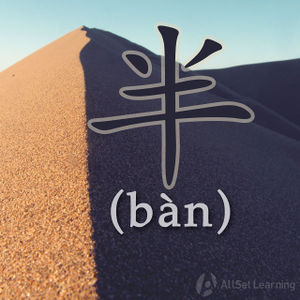Difference between revisions of "Expressing "half" with "ban""
m (Text replacement - "</span> <span class=" to "</span><span class=") |
|||
| Line 80: | Line 80: | ||
<div class="liju"> | <div class="liju"> | ||
| − | *<em>半</em> <strong>天</strong><span class="pinyin"> <em>bàn</em> <strong>tiān</strong></span> <span class="trans">half a day</span> | + | *<em>半</em> <strong>天</strong><span class="pinyin"> <em>bàn</em> <strong>tiān</strong></span><span class="trans">half a day</span> |
*<em>半</em> <strong>年</strong><span class="pinyin"> <em>bàn</em> <strong>nián</strong></span><span class="trans">half a year</span> | *<em>半</em> <strong>年</strong><span class="pinyin"> <em>bàn</em> <strong>nián</strong></span><span class="trans">half a year</span> | ||
| Line 91: | Line 91: | ||
<ul> | <ul> | ||
<li class="x"><em>半</em> <strong>个</strong> 天 <span class="pinyin"><em>bàn</em> <strong>gè</strong> tiān</span><span class="trans">half a day</span></li> | <li class="x"><em>半</em> <strong>个</strong> 天 <span class="pinyin"><em>bàn</em> <strong>gè</strong> tiān</span><span class="trans">half a day</span></li> | ||
| − | <li class="x"><em>半</em> <strong>个</strong> 年 <span class="pinyin"><em>bàn</em> <strong>gè</strong> nián</span> <span class="trans">half a year</span></li> | + | <li class="x"><em>半</em> <strong>个</strong> 年 <span class="pinyin"><em>bàn</em> <strong>gè</strong> nián</span><span class="trans">half a year</span></li> |
</ul> | </ul> | ||
Revision as of 03:47, 24 May 2017
The Chinese word 半 (bàn) means "half." That's simple enough, but what can get slightly tricky is the rules for how it combines with measure words.
Contents
Standard Usage
Used Alone
Structure
You'll need to use a measure word (Measure Word) in this structure.
半 + Measure Word + Noun
Examples
The measure words are also indicated below.
- 半 个 小时 half an hour
- 半 个 月 half a month
- 半 碗 米饭 half a bowl of rice
- 半 瓶 酒 half a bottle of liquor
- 半 份 炒面 half a serving of chow mein
With a Number
When it's more than just a half, then 半 (bàn) comes after the measure word instead of before. It's the difference between "half an hour" and "an hour and a half."
- 半 个 小时 half an hour
- 一 个 半 小时 an hour and a half
The order is actually basically the same as what we do in English (we just don't have so many pesky measure words to keep track of in English!).
Structure
Number + Measure Word + 半 + Noun
Examples
- 三 个 半 小时 three and a half hours
- 两 个 半 月 two and a half months
- 一 斤 半 水果 One "jin" = 500gone and a half jin of fruit
- 一 瓶 半 白酒 one and a half bottles of wine
- 四块 半 巧克力 four and a half pieces of chocolate
Notable Exceptions
There are some words that act as their own measure words, notably the time words 天 (tiān), meaning "day," and 年 (nián), meaning "year."
Used Alone
Structure
半 + 天 / 年
Examples
- 半 天half a day
- 半 年half a year
Note that you do not need to use 个 (gè) here; in fact, it's wrong to do so:
- 半 个 天 half a day
- 半 个 年 half a year
With a Number
天 (tiān) and 年 (nián) aren't the only words that take this alternate pattern, but they're the two key ones you need to learn first.
Structure
Number + 天 / 年 + 半
Examples
- 两 天 半 two and a half days
- 一 年 半 a year and a half
- 三 天 半 three and a half days
- 四 年 半 four and a half years



